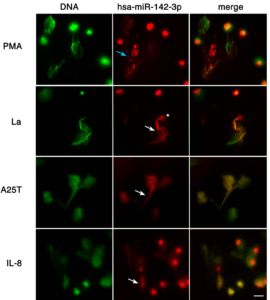
Live-cell imaging of NET formation in two different channels for up to 120 minutes. SYTOX Green at 10 nM was used for NET detection (depicted in green; left panels), and a TYE™-665 labeled hsa-miR142-3p locked nucleic acid (LNA) detection probe at 5 μM for miR-142-3p detection (depicted in red; middle panels). The hsa-miR-142-3p staining was present in two different morphological patterns: one shows a strong staining (asterisk), and the other reveals a weak staining that can be either punctate (blue arrow) or diffuse (white arrows). The right panels show the merge of the two channels. Bars: 20 μm. (Source: Linhares-Lacerda et al., 2020)
NETosis is a process by which neutrophils release Neutrophil extracellular traps (NET)* to trap bacteria. Immuno-pathologies associated with NET and NETosis have been well studied. [Read some of our summaries on NETosis during COPD and gall-stone formation.] However, the complete composition of molecules associated with NET is not fully characterised.
Researchers from Brazil aimed to determine if small non-coding RNA molecules known as microRNAs (miRNA) are associated with NETs. miRNAs regulate cellular processes and can be detected both intra- and extra-cellularly, bound to protein or packaged in lipid-based carriers. They detected miRNA carriers in NET induced by different stimuli. However, detection levels varied depending on stimuli, suggesting a potential “existence of physiological regulation of NET-based miRNA transportation to the extracellular milieu.” Linhares-Lacerda et al., identified multiple NET-associated miRNAs, including miRNA-142-3p, a miRNA implicated in pathology of auto-immune diseases such as lupus, cancer, sclerosis, etc., as well as modulation of lymphocyte function. They showed that miRNA-142-3p carried by NETs could be transferred to macrophages, resulting in reduced TNF-α production through the PKCα pathway.
These results suggest that NETs could be another way in which miRNA could be delivered to cells, inducing in gene-based modulation of cell function. It also highlights the need to explore the activity of other NET-associated-miRNAs and their immune-regulatory capacities.
*NET: DNA (uncondensed chromatin and histones), neutrophil elastase and other granule products.
Linhares-Lacerda et al., 2020. Neutrophil extracellular trap-enriched supernatants carry microRNAs able to modulate TNF-α production by macrophages. Scientific Reports











